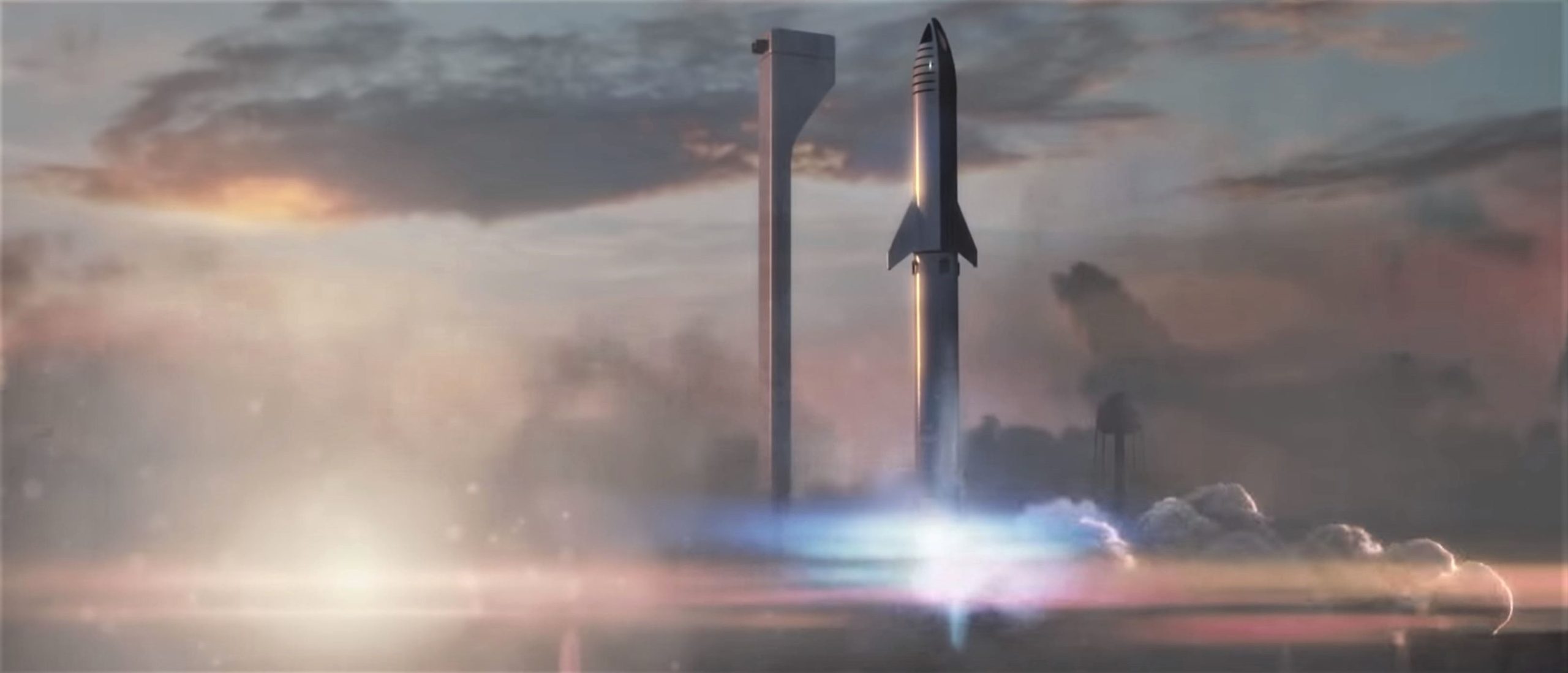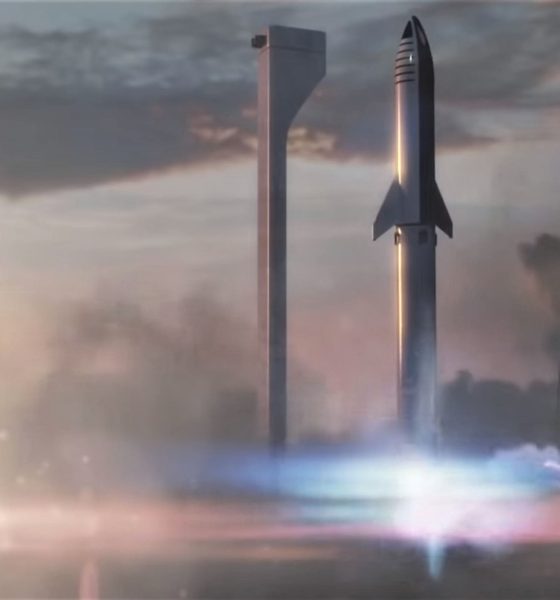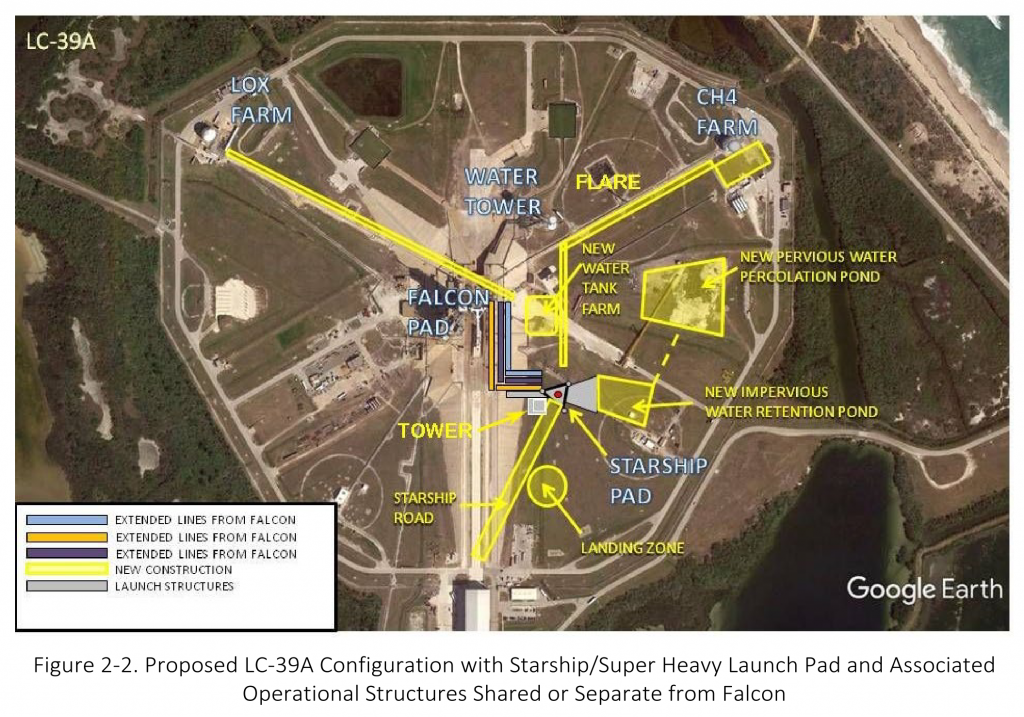

News
SpaceX prepares to break ground on Starship launch facilities at Pad 39A
As of September 14th, SpaceX is nearly ready to break ground on what will likely be the first orbital-class Starship and Super Heavy launch pad, coming in the form of an addition to the company’s NASA-leased LC-39A pad at Kennedy Space Center.
Based on environmental assessment documents published in August 2019, the modifications SpaceX plans to make to Pad 39A are surprisingly minor and could arguably take just a handful of months from start to finish. Once complete, SpaceX will possess dedicated Starship launch facilities in both Florida and Texas, although there is a strong chance that Pad 39A will be ready to support orbital launch attempts well before SpaceX’s Boca Chica launch site is certified.
Per NASASpaceflight.com’s Kennedy Space Center (KSC) sources, the new activity and equipment at Pad 39A was confirmed to be the start of Starship-related modifications. However, the basic location of the new activity supports the theory that the work is Starship-related irrespective of any sourced confirmation.

Maps published in an August 2019 Draft Environmental Assessment (EA) show that SpaceX is currently staging construction materials and equipment in the same quadrant that a majority of Starship’s Pad 39A ground systems will eventually be located. According to the draft EA, SpaceX will likely continue to use its existing 39A hangar, additionally supported by a comment from CEO Elon Musk indicating that Starship and Super Heavy will be more or less structurally stable in horizontal positions. The 39A hangar is large enough to house Starships and Super Heavy boosters, although their presence would almost certainly impact Falcon 9/Heavy operations
Still, Starship and Super Heavy will be vertically integrated into a single ‘stack’ prior to launch. According to SpaceX, a large, mobile crane will be used temporarily and will eventually be replaced with a permanent, fixed-structure crane at some point in the future. Aside from a propellant farm and associated plumbing for Starship’s liquid methane fuel supply, the EA shows plans for new water percolation and retention ponds, as well as a new landing zone located just a few hundred feet away from the planned launch mount.

Until the FAA performs an environmental assessment of rocket landings at Pad 39A, SpaceX will land Starships at its established LZ-1/2 landing zones, while Super Heavy will be exclusively recovered via drone ship until SpaceX has permission to literally perform return to launch site (RTLS) landings.
As with most SpaceX projects, Pad 39A’s Starship-related development is effectively structured in phases. The first phase focuses primarily on suborbital Starship flight tests and will require a relatively spartan launch mount/stand and water-cooled thrust diverter. SpaceX is in the middle of preparing to build the concrete foundation that said Starship launch mount and deluge system will be installed on. Once SpaceX is ready for orbital Starship launch attempts (and thus Super Heavy booster involvement), the company will either stretch the existing launch mount a dozen or so meters taller or build a new structure tall enough to prevent Super Heavy from destroying the concrete foundation.
That latter task will be quite the challenge, given that a full-up Super Heavy booster at full thrust could produce almost twice as much thrust as NASA’s Saturn V rocket, the massive launch vehicle Pad 39A was originally built to support. According to Elon Musk, Starship’s first orbital launch attempt(s) could begin as early as November or December 2019, although sometime in Q1 or Q2 2020 is a far safer bet. Either way, it’s possible that SpaceX will transport Starship Mk2 to Pad 39A as early as this month (September 2019) and the first launch of a Starship prototype (likely Mk1) is scheduled as early as October 13th. Starship Mk2 could be ready for its own flight debut soon after.
Stay tuned as SpaceX continues to fire on all cylinders in pursuit of its fully-reusable, next-generation launch vehicle.
Check out Teslarati’s Marketplace! We offer Tesla accessories, including for the Tesla Cybertruck and Tesla Model 3.

News
Nvidia CEO Jensen Huang explains difference between Tesla FSD and Alpamayo
“Tesla’s FSD stack is completely world-class,” the Nvidia CEO said.

NVIDIA CEO Jensen Huang has offered high praise for Tesla’s Full Self-Driving (FSD) system during a Q&A at CES 2026, calling it “world-class” and “state-of-the-art” in design, training, and performance.
More importantly, he also shared some insights about the key differences between FSD and Nvidia’s recently announced Alpamayo system.
Jensen Huang’s praise for Tesla FSD
Nvidia made headlines at CES following its announcement of Alpamayo, which uses artificial intelligence to accelerate the development of autonomous driving solutions. Due to its focus on AI, many started speculating that Alpamayo would be a direct rival to FSD. This was somewhat addressed by Elon Musk, who predicted that “they will find that it’s easy to get to 99% and then super hard to solve the long tail of the distribution.”
During his Q&A, Nvidia CEO Jensen Huang was asked about the difference between FSD and Alpamayo. His response was extensive:
“Tesla’s FSD stack is completely world-class. They’ve been working on it for quite some time. It’s world-class not only in the number of miles it’s accumulated, but in the way it’s designed, the way they do training, data collection, curation, synthetic data generation, and all of their simulation technologies.
“Of course, the latest generation is end-to-end Full Self-Driving—meaning it’s one large model trained end to end. And so… Elon’s AD system is, in every way, 100% state-of-the-art. I’m really quite impressed by the technology. I have it, and I drive it in our house, and it works incredibly well,” the Nvidia CEO said.
Nvidia’s platform approach vs Tesla’s integration
Huang also stated that Nvidia’s Alpamayo system was built around a fundamentally different philosophy from Tesla’s. Rather than developing self-driving cars itself, Nvidia supplies the full autonomous technology stack for other companies to use.
“Nvidia doesn’t build self-driving cars. We build the full stack so others can,” Huang said, explaining that Nvidia provides separate systems for training, simulation, and in-vehicle computing, all supported by shared software.
He added that customers can adopt as much or as little of the platform as they need, noting that Nvidia works across the industry, including with Tesla on training systems and companies like Waymo, XPeng, and Nuro on vehicle computing.
“So our system is really quite pervasive because we’re a technology platform provider. That’s the primary difference. There’s no question in our mind that, of the billion cars on the road today, in another 10 years’ time, hundreds of millions of them will have great autonomous capability. This is likely one of the largest, fastest-growing technology industries over the next decade.”
He also emphasized Nvidia’s open approach, saying the company open-sources its models and helps partners train their own systems. “We’re not a self-driving car company. We’re enabling the autonomous industry,” Huang said.
Elon Musk
Elon Musk confirms xAI’s purchase of five 380 MW natural gas turbines
The deal, which was confirmed by Musk on X, highlights xAI’s effort to aggressively scale its operations.

xAI, Elon Musk’s artificial intelligence startup, has purchased five additional 380 MW natural gas turbines from South Korea’s Doosan Enerbility to power its growing supercomputer clusters.
The deal, which was confirmed by Musk on X, highlights xAI’s effort to aggressively scale its operations.
xAI’s turbine deal details
News of xAI’s new turbines was shared on social media platform X, with user @SemiAnalysis_ stating that the turbines were produced by South Korea’s Doosan Enerbility. As noted in an Asian Business Daily report, Doosan Enerbility announced last October that it signed a contract to supply two 380 MW gas turbines for a major U.S. tech company. Doosan later noted in December that it secured an order for three more 380 MW gas turbines.
As per the X user, the gas turbines would power an additional 600,000+ GB200 NVL72 equivalent size cluster. This should make xAI’s facilities among the largest in the world. In a reply, Elon Musk confirmed that xAI did purchase the turbines. “True,” Musk wrote in a post on X.
xAI’s ambitions
Recent reports have indicated that xAI closed an upsized $20 billion Series E funding round, exceeding the initial $15 billion target to fuel rapid infrastructure scaling and AI product development. The funding, as per the AI startup, “will accelerate our world-leading infrastructure buildout, enable the rapid development and deployment of transformative AI products.”
The company also teased the rollout of its upcoming frontier AI model. “Looking ahead, Grok 5 is currently in training, and we are focused on launching innovative new consumer and enterprise products that harness the power of Grok, Colossus, and 𝕏 to transform how we live, work, and play,” xAI wrote in a post on its website.
Elon Musk
Elon Musk’s xAI closes upsized $20B Series E funding round
xAI announced the investment round in a post on its official website.

xAI has closed an upsized $20 billion Series E funding round, exceeding the initial $15 billion target to fuel rapid infrastructure scaling and AI product development.
xAI announced the investment round in a post on its official website.
A $20 billion Series E round
As noted by the artificial intelligence startup in its post, the Series E funding round attracted a diverse group of investors, including Valor Equity Partners, Stepstone Group, Fidelity Management & Research Company, Qatar Investment Authority, MGX, and Baron Capital Group, among others.
Strategic partners NVIDIA and Cisco Investments also continued support for building the world’s largest GPU clusters.
As xAI stated, “This financing will accelerate our world-leading infrastructure buildout, enable the rapid development and deployment of transformative AI products reaching billions of users, and fuel groundbreaking research advancing xAI’s core mission: Understanding the Universe.”
xAI’s core mission
Th Series E funding builds on xAI’s previous rounds, powering Grok advancements and massive compute expansions like the Memphis supercluster. The upsized demand reflects growing recognition of xAI’s potential in frontier AI.
xAI also highlighted several of its breakthroughs in 2025, from the buildout of Colossus I and II, which ended with over 1 million H100 GPU equivalents, and the rollout of the Grok 4 Series, Grok Voice, and Grok Imagine, among others. The company also confirmed that work is already underway to train the flagship large language model’s next iteration, Grok 5.
“Looking ahead, Grok 5 is currently in training, and we are focused on launching innovative new consumer and enterprise products that harness the power of Grok, Colossus, and 𝕏 to transform how we live, work, and play,” xAI wrote.








